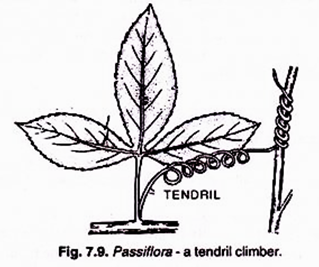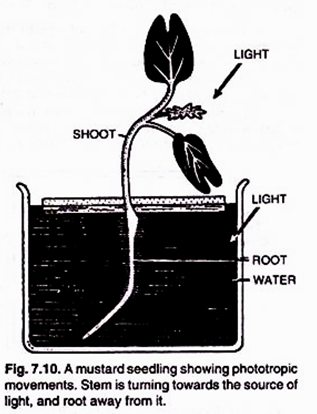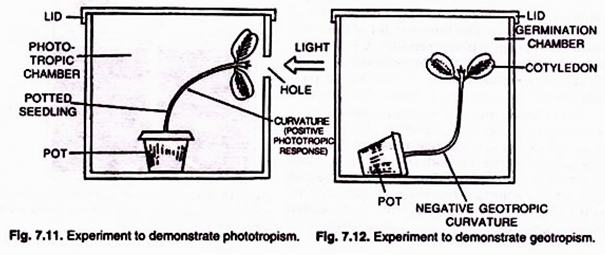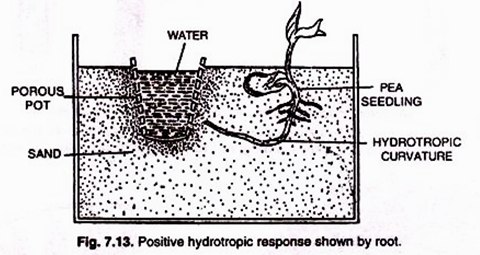The below mentioned article will highlight the six types of tropic movements in plants.
The six types are: (1) Thigmotropism (Haptotropism) (2) Phototropism (3) Geotropism (4) Thermotropism (5) Chemotropism and (6) Hydrotropism.
Type # 1. Thigmotropism (Haptotropism):
Growth movements made by plants in response to contact with a solid object are called thigmotropism. These are curvature movements and are most apparently seen in tendrils and twiners. In most plants the curvatures of the tendrils which follow contact with a support are mostly the result of increased growth on the side opposite the stimulus (Figs. 7.8 & 7.9).
Type # 2. Phototropism:
This kind of movement is induced by light. Not all plants and not all parts respond in the same way to this stimulus. In general, the stem mostly grows and turns towards the source of light, while the roots away from it. As shown in fig. 7.10 the leaves also positively respond toward the source of light. The leaves, however, take up such a position in which the broad surface of the blade is at right angles to the light rays. A stem is, therefore, said to be positively phototropic, a root negatively phototropic, and a leaf transversely phototropic or diaphotropic. Phototropism is also known as heliotropism.
In certain plants, such as Arachis hypogea (ground nut) more complex changes occur within a short period of time. The flower-stalks of this plant initially show positive phototropism until they have produced flowers. Soon after fertilization the stalks curl up and eventually bury the developing pods under the soil, thus showing negative phototropism.
Type # 3. Geotropism:
Any reaction to the stimulus of earth’s gravity is called geotropism. The effects of gravity on plants are not like those of light and temperature because it is both continuous in action and constant in strength. Primary roots and certain other portions of the root system tend to grow directly toward the centre of gravity and hence called positively geotropic.
Stem mostly grows away from the centre of gravity and is thus negatively geotropic. However, stems in prostrate plants have lost their negative geotropism and even develop into root stock or tubers which behave exactly like roots. Most of the leaves take up their positions at right angles to the centre of gravity and are, therefore, called transversely geotropic or diageotropic. Geotropism is of three types: orthogeotropism (e.g. primary root), plageotropism (e.g., secondary roots) and diageocropism (movement of tertiary roots)
Mechanism of Phototropism:
In this example, the positive and negative curvatures shown by stem and root respectively, is the result of the unequal growth of the illuminated and shaded sides of the apex. In case of stem the growth is more on the shaded side while in the root it is more on the illuminated side. More growth of the stem on the shaded side is due to more accumulation of auxin on the shaded side than on the illuminated side.
This unequal distribution of auxins on the two sides may be due to following two reasons:
(i) Translocation of auxins from illuminated side to the shaded side.
(ii) Inhibition of auxins synthesis in the illuminated side.
Mechanism of Geotropism:
Geotropism too can be explained on the basis of differential (unequal) distribution of auxins. In a horizontally placed plant the auxin accumulation on the lower side of the stem and root apices due to gravity. In the stem higher concentration of auxin on the lower side of the apex stimulates its growth on that side. This results in growth of the stem in upward direction showing negative geotropism.
On the other hand, in case of root, the higher concentration of auxin on the lower side inhibits the growth on the upper side than on the lower side. As a result the root apex grows downward (i.e, Positive geotropism).
Demonstration of Phototroptism and Geotropism:
1. Demonstration of Phototropism in Stem:
Take a potted seedling of a plant. Place it in heliotropic (phototropic) chamber with a small hole on one side (Fig. 7.11). Close the top of the chamber. Place it in a position that allows sufficient light to pass through the hole. Keep it there for a couple of days. Open the chamber and observe the seedling. It shows a bending (curvature) of the stem towards the hole (direction of light stimulus). This response is positive phototropism.
2. Demonstration of geotropism in a plant:
Take a potted seedling. Place it horizontally within a dark wooden chamber (Fig. 7.12). Open the chamber after one day. The stem will be seen bent upwards, i.e., in a direction opposite to the pull of gravity. This is negative geotropism. Take the roots out of the pot. They will show a curvature or bend opposite to the bend of the stem. This curvature is in the direction of the pull of gravity. It is positive geotropism.
Type # 4. Thermotropism:
Some of the plant organs markedly respond towards fluctuating atmospheric temperature. In response to this kind of stimulus plant parts exhibit curvature movements in order to take some advantageous position. Such movements are called thermotropism.
Type # 5. Chemotropism:
Certain chemical substances are responsible to bring about curvature movements in plant organs. For instance, movement of Pollen tube towards ovary due to absorption of calcium and borate from style of carpel; movement of tentacles in Drosera, closing of lid of Nepenthes due to nitrogenous food, and penetration of haustoria of parasite into host body etc.
Type # 6. Hydrotropism:
The paratonic curvature movements of growth in relation to the stimulus of water are called hydrotropic movements. The tropic response to the stimulus of water is called hydrotropism. The roots show positive hydrotropic response, i.e., they bend towards the water (Fig. 7.13). Hydrotropism is stronger in roots compared to geotropism.
The exact mechanism of hydrotropic response is not know. Probably roots detect and react to differences in the concentration of water.




